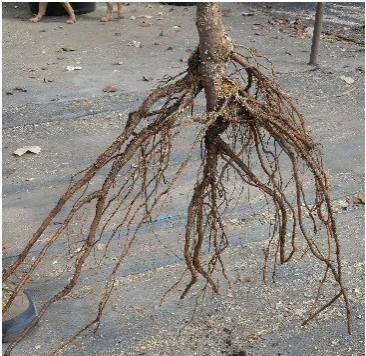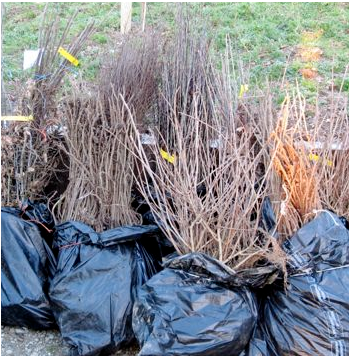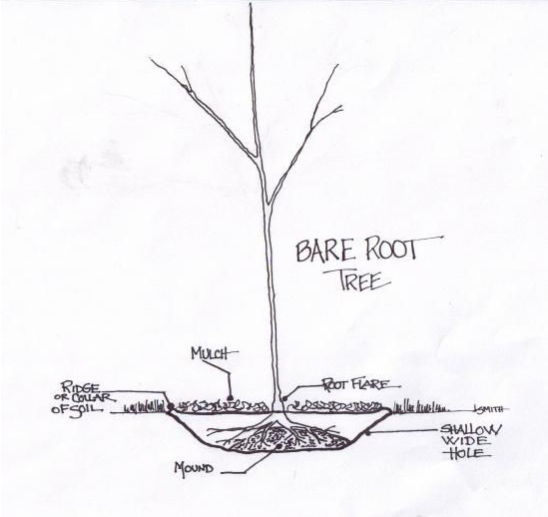Bare root plants are leafless, in a dormant state and without soil on their roots, thus the name. They are generally quite a bit smaller than similar plants purchased in containers, but they are also 40-70% less expensive. Many deciduous plants are available this way, including fruit and shade trees, flowering shrubs, roses, grapes and cane fruits. Buy from a reputable source to ensure you are purchasing vigorous, healthy plants.
Note: Bare root plants suffer much more from transplant shock. They will need time to recover.

Bare root tree
Care when your bare root arrives
- Bare root plants are planted in early spring as soon as the soil has thawed and is dry enough to work in.
- Bare root should be planted as soon as possible after delivery/purchase.
- If the soil or weather conditions make this impossible, carefully inspect the plants for health.
- Store them in a cool, non-freezing location.
- Be sure the roots remain moist by keeping them in original packaging, loosely wrapped or in plastic bags.
- Store them out of the sun or wind.

Planting
- Once the conditions are optimal for planting, carefully remove the plants from their packaging, cut off any dead or damaged branches and roots.
- Soak the roots in a bucket of water overnight.
- Dig the holes wide and shallow.
- Do not loosen the soil beneath the roots.
- Do not amend the soil in the hole.
- Choose plants that can tolerate the type of soil conditions in which you are planting.
- If you are planting in heavy soils, make the hole even wider and be sure to loosen up the side walls so the roots can penetrate them.
- The hole should be no deeper than the longest roots at the bottom.
- The hole should be 2-3 times wider than the entire root mass.
- The depth is determined by the plant, itself.
- In the case of a tree, once planted, the root flare should be at or a little above the soil level.
- In the case of a shrub or other type of plant, the area where the branching starts at the base of the stem should be slightly above the soil level, once planted.

Making a "Collar" ensures that water reaches the roots rather than runs away.
- Once you have an appropriate size hole, create a firm mound or cone of soil in the center.
- Spread the roots carefully over this mound so they are draping out and down.
- Position the plant in the hole so it is correctly aligned and upright.
- Begin backfilling.
- Take your time, making sure to tamp down the soil around the roots to eliminate any air pockets.
- Once backfill is complete, check your level and alignment.
- If it is too low or not straight, correct this.
- Create a soil “collar” at the perimeter of the planting hole to ensure water goes into the roots and does not run off when watering.
- Water thoroughly.
- Mulch each planting bed making sure to keep the mulch at least one inch away from the base of the plant. Think Donut not Volcano.
The experts at Gertens are always available to answer your questions!
